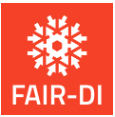Speaker
Description
A lot of materials knowledge is obtained in an indirect manner, e.g. by fitting model parameters to data that is being acquired in some potentially very complex experiment. Electron microscopy data, for example, can be several 10s of GB; and especially for these very large sets of data, complex data analysis workflows (DAWs) must then be run, for extracting the materials property information that is being sought. In order to be used by researchers in the field, these DAWs are accompanied by an extensive user manual and often also a complex GUI, both of which must be updated every time a new feature is implemented in the DAW, or a new set of parameters controlling the DAW, has been discovered to improve performance. Before being able to utilize the functionality provided by the DAW, any person planning to apply it has to make himself / herself familiar with the specific sequence of commands, or the scripting commands, or the GUI operations that are required to perform the analysis, and it may not be very obvious to the person learning this operation, how to choose optimal parameters / settings. Together with the need to first install the software providing the DAW on a local computer, or server, the hurdle of having to first familiarize with its operation may prevent its use in many cases. Making the DAW available online with an LLM-based agent with access to the API documentation for resource-augmented generation (RAG) makes it usable for novice users immediately and reduces the effort to develop and maintain a GUI, keep the full documentation up to date, or train new users. Multiple and very different DAWs can be offered through the same interface. Example DAWs from the field of electron microscopy will be presented.
